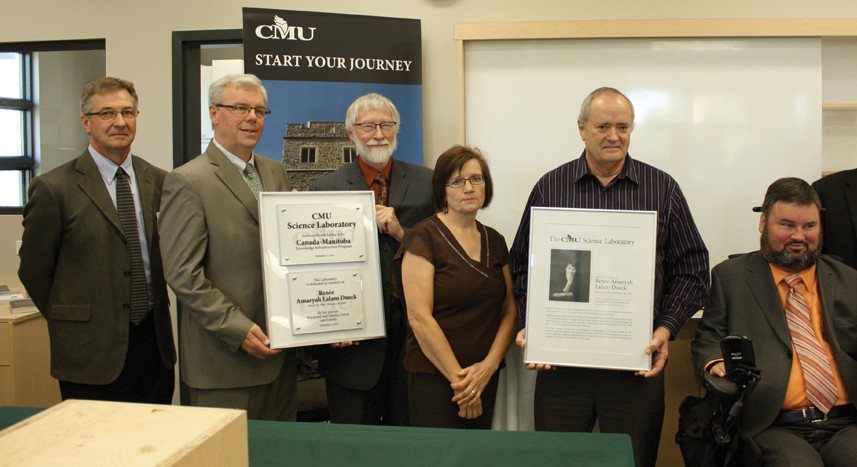Suderman to perform September 25 in CMU’s Laudamus Auditorium
For release September 9, 2010
CMU is pleased to bring beloved Canadian singer and songwriter Bryan Moyer Suderman to CMU for a free public intergenerational concert on September 25, 2010 at 1:30 pm. This performance is offered as part of CMU’s broad range of homecoming and 10th Anniversary celebration events to which both the CMU family of alumni and friends and members of the broader community are most welcome to attend.
Bryan Moyer Suderman has a gift for writing songs that are deeply scriptural, musically memorable, and readily singable – songs that are at once simple, catchy, profound, and fun. Since the release of his first studio album “God’s Love is for Everybody” in 2002, Bryan’s “songs of faith for small and tall” have become favorites of families and congregations across North America and beyond, and have been published in numerous hymnal, songbook, and curriculum resources, including the Gather Round Sunday School curriculum, Leader magazine, and the Church Hymnal 4th Edition of the Church of Scotland. Bryan’s newest release, “A New Heart,” is his 4th CD on the SmallTall Music label (www.smalltallmusic.com).
“Like all really good singer and songwriters, Bryan has the gift of turning mountains of careful thinking and compassionate outcries into pearls,” says Cheryl Pauls, Associate Professor of Music at CMU. “Bryan’s pearls live in time, and they make us want to believe in the hope and the healing of the Jesus through whom he sings.”
Bryan has many years of experience performing and inspiring people to sing, whether in congregational settings, house concerts, or large ecumenical conventions and conference events including various Mennonite Church Canada/USA assemblies and Mennonite World Conference Assemblies in Zimbabwe (2003) and Paraguay (2009). Audiences respond to the warmth of his voice, the contagious nature of his songs, and his signature interactive style of singing and song leading.
Bryan lives near Toronto, Ontario with his wife and son, and travels extensively, mostly by train, living his vocation of “building up the body of Christ by creating and sharing songs of faith for small and tall.” You can find out more about his music ministry at www.smalltallmusic.com, and about his innovative “community supported music” initiative at www.bryanmoyersuderman.com.
The Bryan Moyer Suderman concert is being held at 1:30 pm in CMU’s Laudamus Auditorium, situated on CMU’s north campus at 500 Shaftesbury Boulevard.
Other weekend events include Friday evening’s tour of CMU’s Science Laboratory, a two-piano concert featuring Cheryl Pauls and Verna Wiebe, a science and faith lecture, “Seeing more clearly in a blurry landscape: science and ambiguity,” by Assistant Professor of Biology John Brubacher, along with a few basketball games. Saturday’s events include soccer exhibition games, Menno Cross, which is a cyclo-cross bike race, a dinner and awards evening, and a time of worship at CMU’s annual Choral Evensong, featuring CMU’s talented ensembles along with a volunteer alumni choir, conducted by Janet Brenneman and Rudy Schellenberg.
CMU’s full weekend schedule can be viewed online at www.cmu.ca/homecoming.
Canadian Mennonite University (CMU) is a Christian university in the Anabaptist tradition, offering undergraduate degrees in the arts and sciences, business, communications and media, peace and conflict resolution studies, music, music therapy, theology, and church ministries, as well as graduate degrees in Theological Studies and Christian ministry. Located in Winnipeg, Manitoba, CMU has over 1,800 students at its Shaftesbury Campus in Southwest Winnipeg, at Menno Simons College in downtown Winnipeg, and enrolled through its Outtatown discipleship program. CMU is a member of the Association of Universities and Colleges of Canada (AUCC)
For event information, contact:
Eleonore Braun
CMU Alumni Coordinator
Tel. 204.487.3300 Ext. 605
ebraun@cmu.ca
For CMU information, contact:
Nadine Kampen
Communications & Marketing Director
Tel. 204.487.3300 Ext. 621
nkampen@cmu.ca
500 Shaftesbury Blvd.
Winnipeg, MB R3P 2N2


